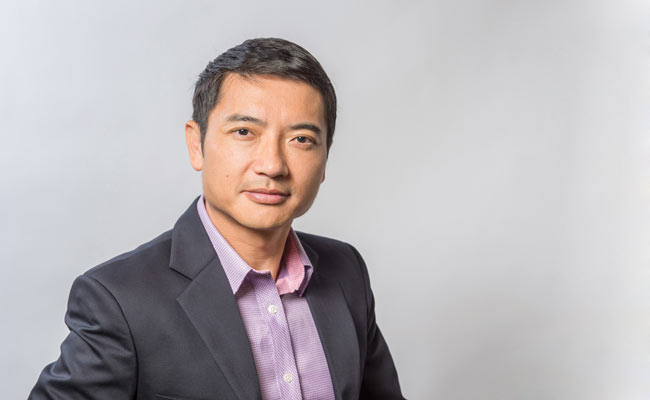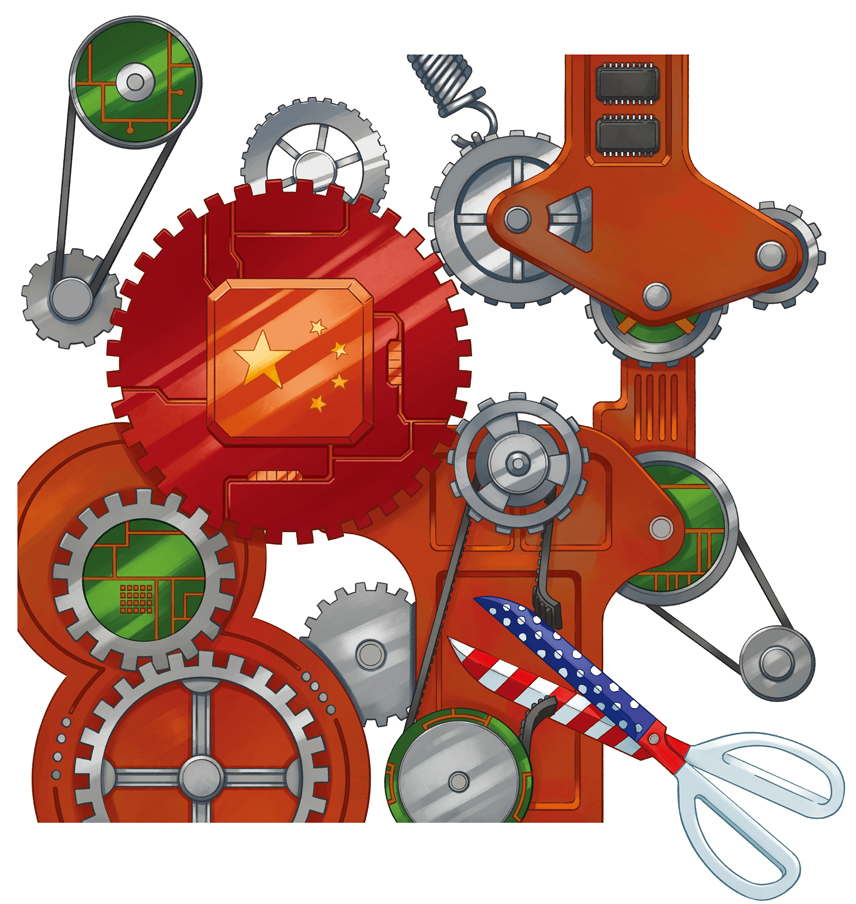Allen Wu, chip designer ARMʼs Greater China President, explains how the company is navigating Chinaʼs increasingly treacherous environment for foreign companies.
Since May, the Chinese government has been urging many state agencies and state-owned enterprises (SOEs) to reduce or cut entirely their use of foreign tech providers. The orders have impacted firms from Microsoft and IBM to internet security provider Symantec. Yet in this tense climate, UK-headquartered semiconductor manufacturer and designer and Intel rival ARM is actually seeing more opportunities open up.
With key foreign customers Apple and Samsung playing hardball in China, and newer customers in the domestic mobile device market like Huawei, ARM is ingraining itself in the very fabric of Chinaʼs mobile market, according to Allen Wu, Greater China President for ARM, which derived 26% of global revenue from the region last year. ARM lays claim to the architecture in 95% of the worldʼs mobile handsets, and according to IDC, the company will hold 13% of the PC chip market by 2015. Wu explains how his company achieves this and gives his thoughts on what mistakes foreign tech firms are making in China.
Q. The global semiconductor industry appears to be staging a rebound after really suffering from the financial crisis. Do you agree with that assessment? How do you see the Greater China region fitting into that global semiconductor ecosystem?
A. From an overall industry perspective, clearly we have seen some drivers that are actually driving some growth going forward, and actually have already driven a lot of growth in the last four or five years since the crisis. The driver primarily comes from the consumer perspective. China represents the emerging market, along with its ecosystem and so on, whereas the internet is sort of like the prevailing force that kind of levels the playing field a bit, in terms of information and everything. These are probably the leading drivers.
But specifically to the semiconductor industry, I would say that number one, if you look at the China or emerging market angle, youʼve got a huge growth of [a] new class of consumers. Certainly these consumers today may have a spendable income relatively speaking lower than their counterparts in the West, but how the greater China electronic system or IT system is set up, is that they find ways to hock down the system, and make it so efficient that actually itʼs quite affordable to these people. For example, if you look at the majority of the smartphones sold in China, the biggest smartphone is actually in the RMB 700 [price range] or below.
Q. So Xiaomi phones, for example?
A. Yes. Youʼve got a consumer aspect. And the second aspect, how that reflects to the semiconductor industry, is [the] interesting bit, is that because it is really consumer driven, so its lifecycle is actually fairly fast. You throw your phone away every year. And even the pad, the tablet, you buy it and a year and a half later [the next generation] is so much better and essentially itʼs pretty much the same price, Iʼm just going to upgrade, right? You see a lot of that happening.
That means two things. One is that the market itself is expanding, because of the cycle. Two [is the] consumer experience or taste or whatever, they are pay-scale driven, so IT is very diversified. Probably for the first time in the history of IT or electronics, this is like selling a handbag. It could be the RMB 30 one off the subway station, or it could be $30,000. Consumer demand is just very long tail, itʼs very fragmented. So in turn, that actually drives the growth of semiconductor industry.
Q. How do you, as a semiconductor manufacturer, stay flexible between the bread and butter of serving high-margin, high-end products such as the iPhone and iPad and the large swathe of cheaper smartphones hitting the market?
A. That really cycles back to fundamentally how long-[game] the business model has been. ARMʼs business model is about taking [a] percentage. We take percentage of whatever your component is going to cost. The iPhone is probably four or five times more expensive than the regular phones in China. But from our perspective, our model is that we take a percentage of the final chip [used in a phone]. We take a cut of the value we produce.
Frankly, we can either get it at the higher-end margin, lower volume, [or actually which we prefer] is whatever your price, bigger volume the better, because we take [a] very, very small portion… we are taking probably a couple of percent [of the final cost]. So from that perspective, we look at the volume. We didnʼt really intend or target the [smartphone] area. What we do is we say, “Okay, letʼs provide a fundamental piece of technology platform and letʼs have a model—you know what, theyʼre [a phone maker is] going to make it big if theyʼre successful, and weʼre going to take a small cut of that”. Itʼs a model thatʼs so consistent, they go, “Okay, even if I become really successful going forward, I know I only still have to pay a small percentage to ARM.” So basically thereʼs really no need for me to look for another alternative. Because whatever alternative thereʼs going to be, [there] isnʼt going to be that much cost difference but itʼs actually going to take away a lot of value.
Q. Given the ongoing problems of protecting intellectual property (IP) rights in China, what measures does ARM take to protect itself when taking on a new client?
A. Before we deliver the product as part of a contract we do conduct an IT audit. I mean, obviously itʼs not a very extensive audit, but we do have some IT requirements that they have to put in place in order for us to deliver the intellectual property. Most customers are very accepting of that because again, they want to protect theirs [IP], so normally they already have something like this in place.
The second aspect of it is, in our business model, [it is that] in order for you to start a project you need to invest a lot of money, and whatever you pay ARM is [only] a small piece of it. When you are successful, you need to ship millions, or tens of millions or even hundreds of millions [of units] to make a lot of money. So in that scenario, if you are so successful shipping tens of millions… paying ARM a bit is probably the last thing they worry about. We are fortunate in that sense, that weʼre so small, essentially it doesnʼt really pay to really have an IP problem with ARM. The risk and return just doesnʼt come out at all.
Q. In that sense, is it kind of an equal consideration between Chinese companies and foreign companies?
A. Yeah, we have equal consideration, and itʼs really interesting, our partners, our customers want it that way too. They figure, we have a property license in ARM, so [they think], “Iʼm not going to tolerate anybody even thinking about having a kind of backdoor whatever.” I mean business is business, thereʼs no difference really.
Q. Do you see mainland China catching up in terms of the design talent?
A. I think they are catching up, but they still have a gap. Thereʼs a 15-year gap thatʼs not easy to overcome. Now, the interesting bit on that is that in China the talented engineers will go on the management track, because of the lack of deep experienced people. Whereas Taiwan, itʼs long enough that there are a lot of senior engineers that are technical track. ARMʼs business is not doing entry-level stuff, itʼs doing fairly advanced, I would say probably the most challenging part of the device. What we want is really a lot of experienced, talented technical-track people. Itʼs much easier to find in Taiwan because of that situation.
Q. Recently there has been official pressure on Chinese state-owned enterprises to curtail the business they do with foreign tech companies. Do you feel any blowback from this?
A. We are actually not impacted by that very much, for two reasons. One is our business model is about enabling and leveling the playing field, and weʼve been talking about this message for the last six, seven years, probably even longer than that, how we as a technology company enable new developments, especially people focusing on Taiwan, China. So that model lends itself to that. Weʼve had a fairly close engagement with relevant ministries on that aspect. From our point of view we are not viewed as being a problem, so to speak, at this point.
Q. Your model is to be a key part of the value system and level the playing field, but a level playing field does not seem to be a priority for the government as they apply pressure on foreign firms, but rather to boost Chinese businesses. So how do the two fit together?
A. In the end-part services [sector], you see some of that. So what we do is provide the technology platform and the framework. They need us to get to that end product. Relatively speaking, in the chip design business, the Chinese industry is still behind North America and Taiwan, from capability and market share and everything else. So without us it would be like shooting themselves in the foot.
Q. Well, as we saw in May with the ban on ties between US consultancies and SOEs, it is not outside of the governmentʼs capability to make a decision that is seemingly not self-constructive. So again, wouldnʼt ARM need a contingency plan in such an event?
A. There has been a consistent effort to try to build something in parallel, indigenous. And honestly I think this probably will still go on, and I understand that. There is a sense of need for a big country like China to say, “I have to have the same thing everybody else has.” But we donʼt worry about that. So what we do is we actually go engage with our partners in industry and make them successful. If theyʼre successful and your entire industry [finds it] easy to work with you to run their business, youʼre going to be there.
In fact, [weʼve] seen recently since this year a loosening up [in] policy, allowing ARM into more spaces, into electronics and into industry sectors. So from our perspective, we actually see improvement over the last few years. But itʼs not easy. They had a policy which restricts us in certain spaces, in some government funding [procurement], but they realize that actually having us in there is much more beneficial than keeping us out, it just takes some time.
Q. That seems like a fairly big accomplishment, getting to the point where you are seen as indispensable in the value chain. Whatʼs a tangible example of how you really make yourself indispensable?
A. I use the example of a server business. China always wanted, for good reason, to have the ability to design advanced server chips so they can have their own servers, and given quality and everything, the server is such an important piece [of equipment] and given the [information they store] itʼs probably even more sensitive.
So what we do is we—and there is concern on relying on ARM if one day ARM pulls out—actually [grant] licensed local companies the right to design their own microprocessors, [so] even if ARM does not supply, they can design their own. We give them a license such that whatever they design, itʼs fully compatible with the current ecosystem. So they do have a sense, yes, [of] “I do have control of my own destiny.”
Working with partners in China, it is important to make sure they understand they do have control of their own destiny. Economically, [doing it on] their own might not make sense, but they do want a sense of the ability to move on if we were no longer there.
Q. What goals would you say ARM is helping the government to achieve?
A. We help them achieve a couple of goals. Number one, you probably hear this all the time, in terms of dollars they spend more money on the chips they import than they spend on oil. So they want to enable a local IT industry. I would say China wanted to have a CPU [central processing unit] business forever, and the government funded a gazillion projects [yet] the only time they finally have an attraction worldwide on a significant percentage of CPUs is on the tablets and on smartphones.
Q. In the semiconductor sphere, what kind of mistakes do you see other multinationals making?
A. I think the first thing you should never do is assume your technology is so advanced that youʼre going to trump everybody and you can live off that. The technology barriers everywhere are reducing rather than increasing. Never underestimate the ability of local companies to get there. Not only because of how the society is [today], but for example, today Huawei is able to recruit global talent. So I donʼt think there will be any barrier from technology perspective on that issue because today the increase in technology really resides with people and talent, rather than a specific infrastructure. And the other thing is engage with the government, understand what they want to achieve. The policy is just a reflection of certain goals they want to achieve. You just need to figure out, okay, thatʼs the goal they want to achieve, and the policy may not work out for you, [so] what can you do to help them achieve their goals while maintaining or growing your business? Thatʼs a challenging balance.
Q. Of all the mainland companies, if there is a contender that could enter ARMʼs competitive sphere, would it be Huawei?
A. No. Huawei is one of our biggest customers in China, and actually [we] are supposed to be strategic partners, and we are in every single of their product lines. So frankly, I donʼt see anybody at this point. Because this CPU business is such a difficult business, in terms of not just technology, I think that piece is relatively overcomeable, itʼs that you need a global ecosystem support. It takes probably 20 years to achieve that. We are fortunate to get there. If you look at it 20 years or even 10 years ago there were so many CPU companies, and they all fell by the wayside. Essentially now itʼs just Intel and ARM.

















